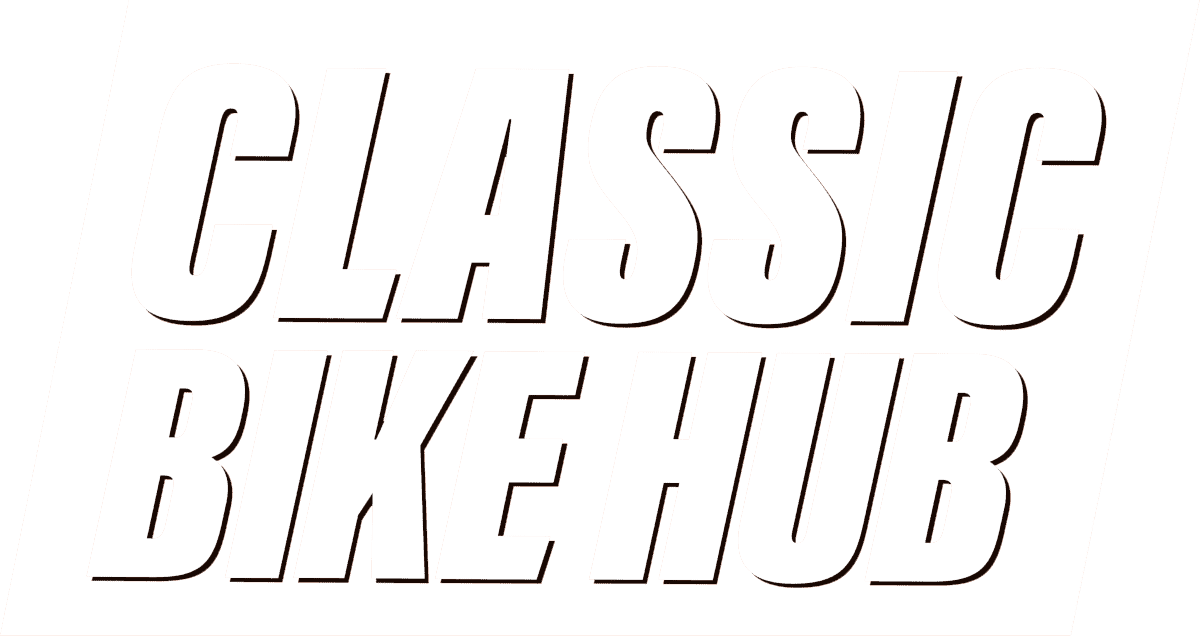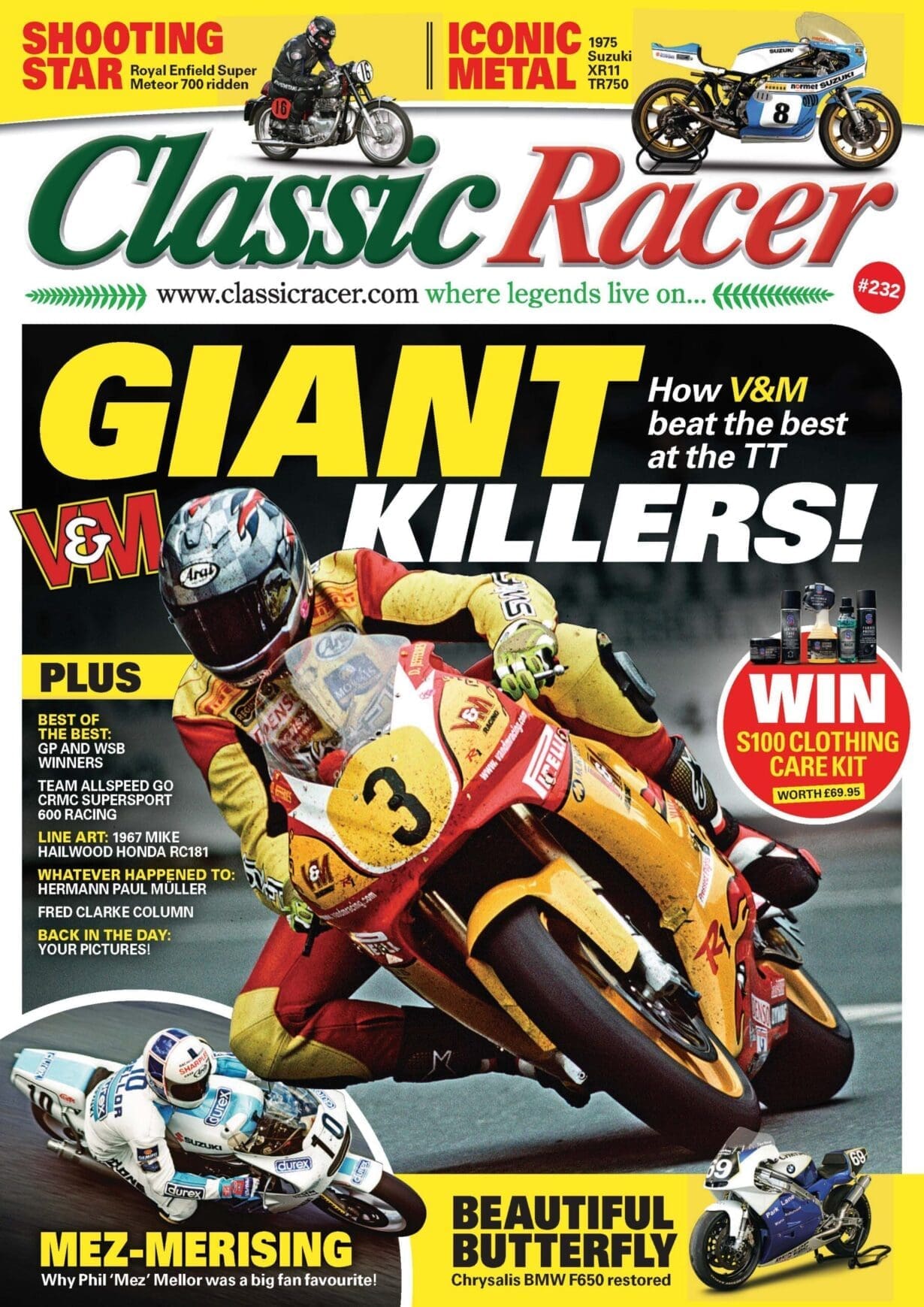Eight World Superbike Championships in a decade marked Ducati’s 888 and 916 production racers as ‘simply the best’ but it wasn’t always plain sailing for the Bologna bullets.

Words: Bertie Simmonds Photographs: Mortons Archive, Kel Edge
If one man created the World Superbike Championship it was former racer and businessman Steve McLaughlin.
In the mid-1980s he and French journalist Phillippe Debarle argued that there should be a world championship for four stroke machines, and after lobbying both the FIM and the various international circuits – as well as tying up a TV deal – the seeds were sown.
However, the fledgling World Superbike Championship needed manufacturer support if it was ever going to rival or replace the TT F1 World Championship. Honda and Yamaha were on-side, Honda fielding their new VFR750R (RC30) and Yamaha the FZR750R. The Yamaha came in both aluminium and steel framed versions as the OW01 was still a year off. Both were run in private teams, as was Kawasaki with the GPX750R. Bimota jumped from the F1 series and wielded their YB4 Ei (FZR powered) while Ducati fielded former 500cc world champ Marco Lucchinelli on their 851 machine.
The smaller factories like Bimota and Ducati only had to produce some 200 units of a road machine to homologate the racer and while it’s beyond the scope of this article to say whether or not the two Italian factories had produced the numbers or not, McLaughlin himself claimed he saw more than 200 851 frames at the Ducati factory, while others doubted the requisite number were produced.
Either way, the first two WSB titles went to Honda and the Rumi-backed RC30 of Fred Merkel in 1988 and 1989. The signs were there for Ducati (fifth in 1988 overall, with two wins) and third overall in 1989 with Raymond Roche winning the most races (5).
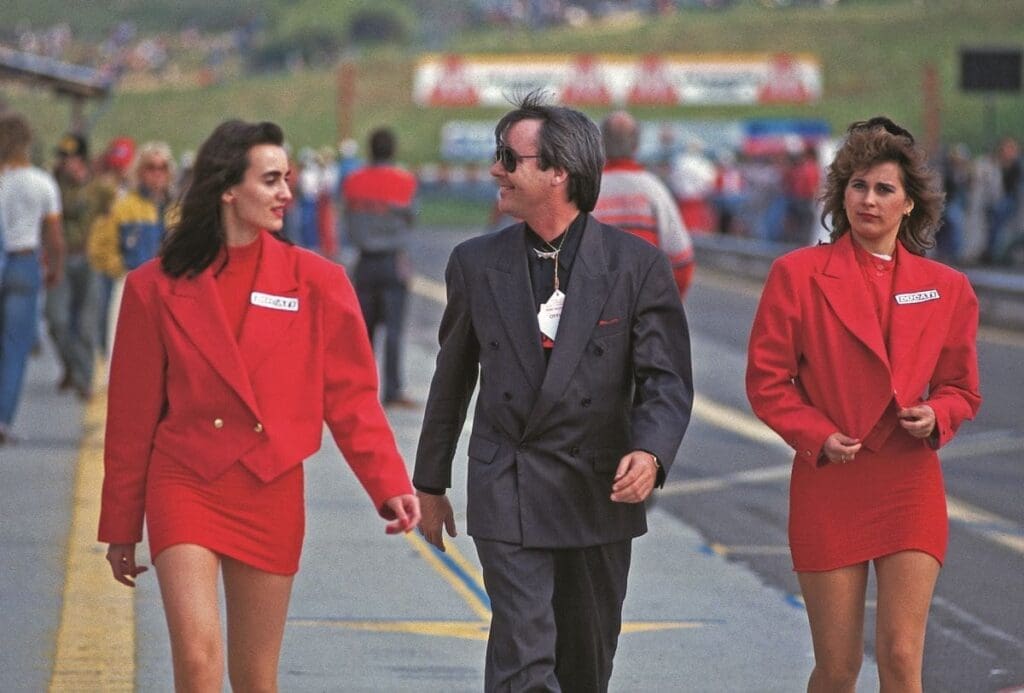
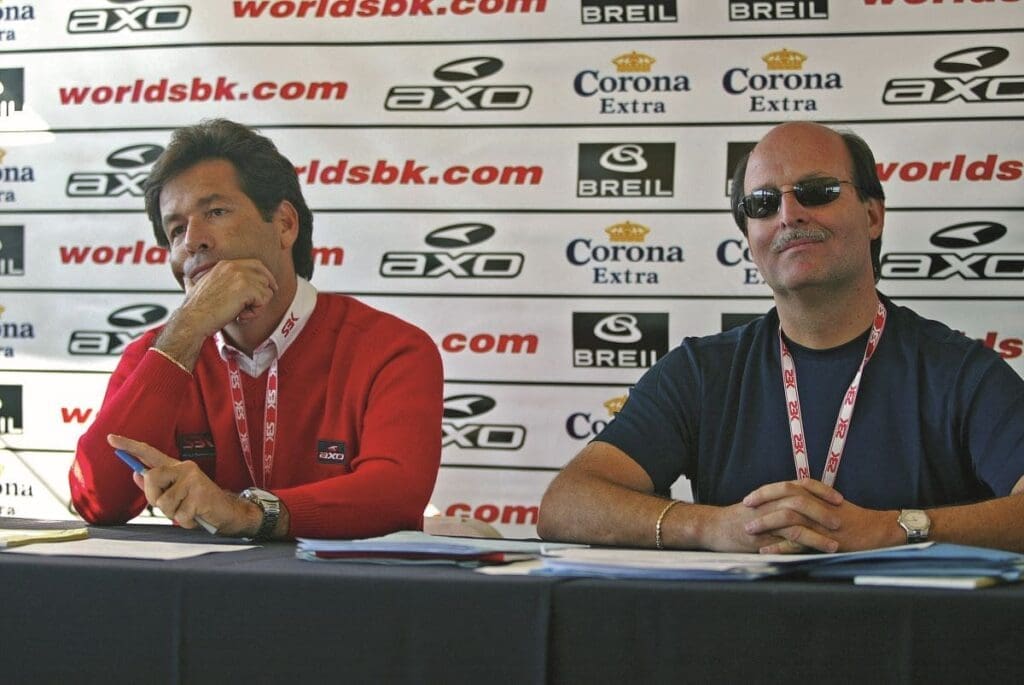
The dawning of a new decade saw The Flammini Group take over the running of the World Superbike Championship, headed by brothers Maurizio (a former racing driver) and Paolo Flammini, and it marked the start of Ducati domination.
Ducati’s ace-in-the-hole was exactly that: the holes in the engines of their racers could get bigger. Initial rules were a simple trade-off between V-twin capacity of up to 1000cc and four-cylinder capacity of 750cc. Over the 1990s engine sizes in the red bikes ranged from 888, through 926, 955, 995, 996, 998 and even 999cc – according to the rumours. Weight limits were initially favouring the twins (140 kilos to 165 kilos) and McLaughlin later claimed this should have been a 25lb not kilo difference, and blamed the FIM for making the mistake. Either way, not many of the Ducatis (even factory ones) could get close to 140 kilos and by 1995 following much Ducati domination the weight of the twins went up and the fours down, and by 1996 the weight limit for both twins and fours was equated at 162 kilos.
The rules would be a source of discontentment for some (four cylinder riders), while the twin riders would say the fours were more powerful. It was plain to see that sometimes the grunt out of the corners clearly favoured the V-twins and they never seemed shy of top-end either. At Daytona in 1996, Scott Russell said: “The Ducatis have such an advantage – they really should be in Grand Prix racing, not Superbike.” This advantage and the sheer numbers of Ducatis on the grid led Aaron Slight to complain in 1996 that: “There’s always another f*cking jerk on a Ducati!”
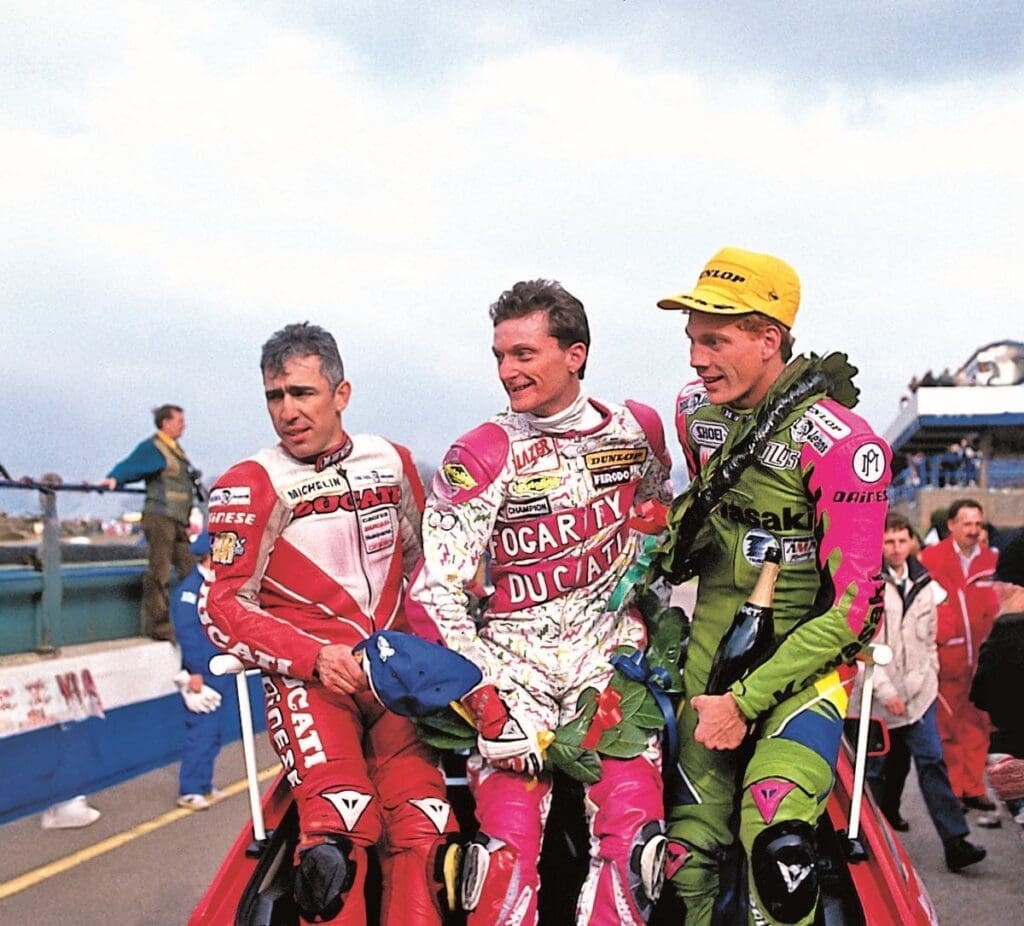
Ducati’s first champion was Raymond Roche – the grizzled former 500cc Grand Prix campaigner. He took his title in 1990 with eight victories and a sizeable lead over runner-up Fabrizio Pirovano on his Yamaha. Roche wouldn’t get title number two, instead he’d take his turn as runner-up in 1991 behind another factory Ducati 888, albeit one run by the American Fast by Ferracci team. The rider was Doug Polen and the Texan would dominate the 1991 and 1992 seasons. He’d win the 1991 championship with five races to spare and eventually take 27 wins over his time in WSB (17 in 1991, nine in 1992 and his GSX-R750 win – Suzuki’s first – in 1989.) 1992 would see the first of 59 wins from Carl Fogarty. Foggy – bored of trying to make a Honda RC30 competitive – had bought his own privateer 888 and crashed in race one at Donington Park while leading, before winning race two. Carl would tell the press: “No one came here to watch a Frenchman win.” Race one winner Roche would turn to Foggy and say: “You will be World Superbike champion – but not this year.”
Roche would manage Fogarty in the factory Ducati squad in 1993, a year marked out by the rivalry between Carl and the Muzzy Kawasaki-mounted Scott Russell – the only straight-four 750cc title winner. It was mighty close, with Fogarty scoring 11 wins to Russell’s five, with the final round being cancelled.
1994 saw the introduction of the Ducati 916. A machine derived from the 888 it had an updated frame and chassis, as well as improvements to the desmoquattro motor originally designed by Massimo Bordi. The looks were the thing – completely different from the workmanlike 888, this was all svelte curves, with twin under-seat pipes and a single-sided swingarm.
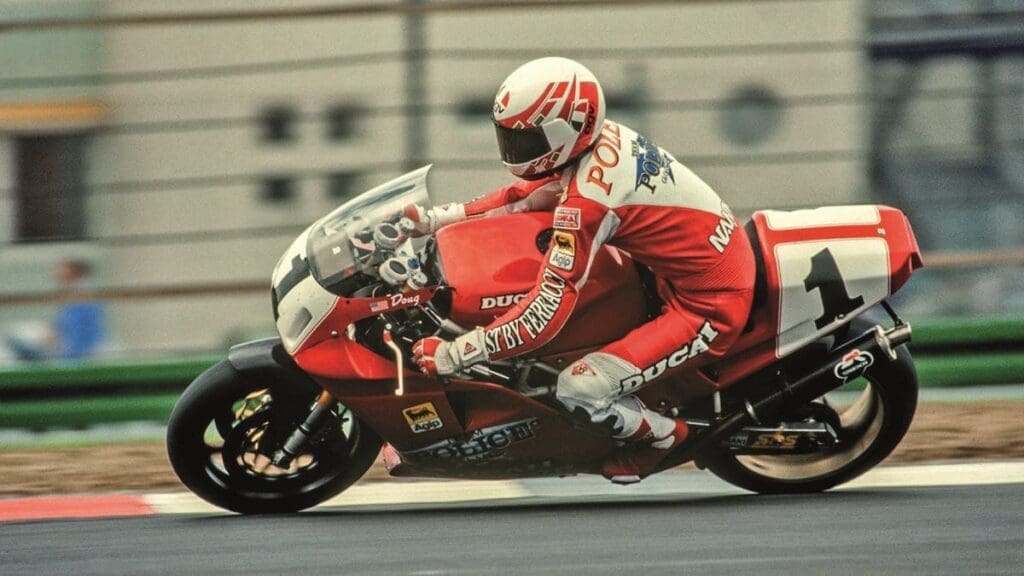
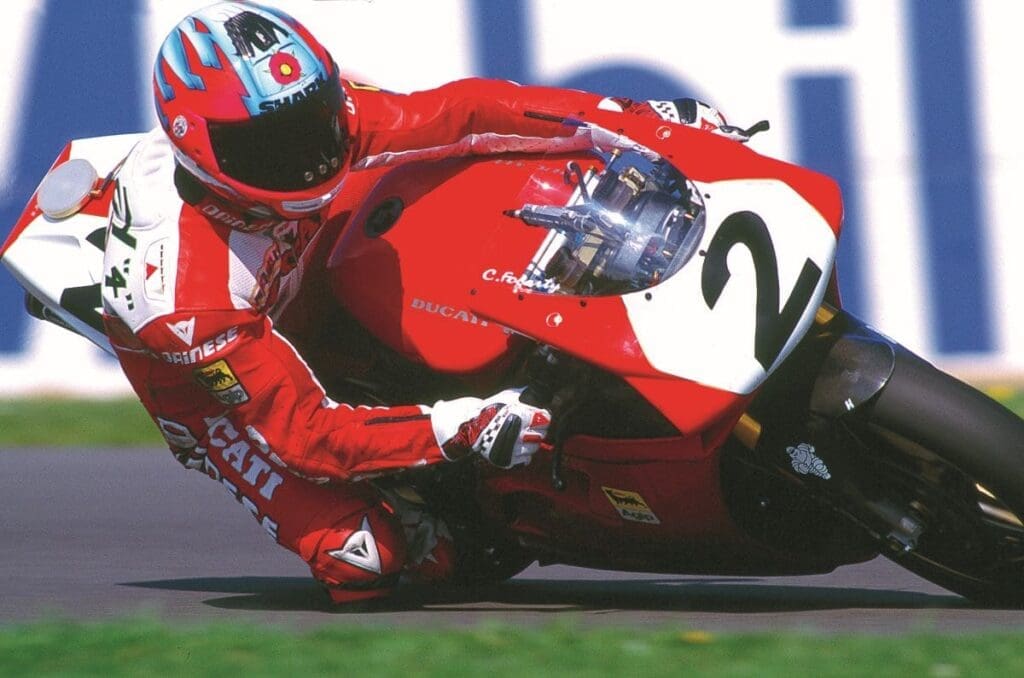
Foggy recalls: “I saw it for the first time and thought ‘f*cking hell’ that’s too beautiful to ride, what if I drop it?’ It was a Ferrari on two wheels, just an amazing piece of art and machinery and so ahead of its time. When I went out on track for the first time it wasn’t easy to ride: in fact the old 888 was better. The 916 racer was nervous, short, twitchy… we made the thing longer overall with a long swingarm then kicked the front out and it was suddenly built for my style of riding.”
With little in the way of pre-season testing then, Carl found himself in a new team, run by Virginio Ferrari, and with a new bike to develop: then he crashed and broke his wrist at the second round in Hockenheim and missed both races. Russell made hay, winning four races off the bounce in the UK, Germany and Italy. Carl would respond in kind with doubles in Spain and Austria. The title would go down to the wire in Phillip Island where the Brit would take the title with 10 wins to the American’s nine.
The following year would be total domination – and not just for Fogarty. He’d take the title by 139 points from runner-up Troy Corser – another Ducati rider. Five Ducatis would feature in the championship top 10 – Foggy would leave for a troubled year at Honda, but other Ducati riders would come to the fore.

Corser was one and he would triumph in 1996 – despite fierce competition from Ducati-mounted John Kocinski, Honda’s Aaron Slight and Carl, as he got to grips with the Honda V4. In his first full season Aussie Troy would shock everyone with his 1m 33.47s lap record of Donington Park at round two – faster than the-then quickest 500cc Grand Prix lap-time. During this season the frailties of the (by now) 955cc motors was clear. Some paddock rumours were that the Promotor/Power Horse team were being nobbled by the Ducati factory and given duff motors, but by the end of the season Kocinski had fallen out with the Ferrari-run team so badly, that Virginio himself begged Foggy to beat Kocinski out on track.
Honda’s only RC45 title would come in 1997, and Foggy would return to the factory Ducati team – but the issues with the bike and Kocinski’s genius in the dry/wet races, meant the mercurial American would take the title.
1998 would see three factory Ducati riders in Fogarty, Corser (returning from an abortive 500cc GP career) and Frankie Chili. Virginio Ferrari ran the main Ducati team with Corser/ Chili, while Davide Tardozzi had Fogarty in a separate outfit.
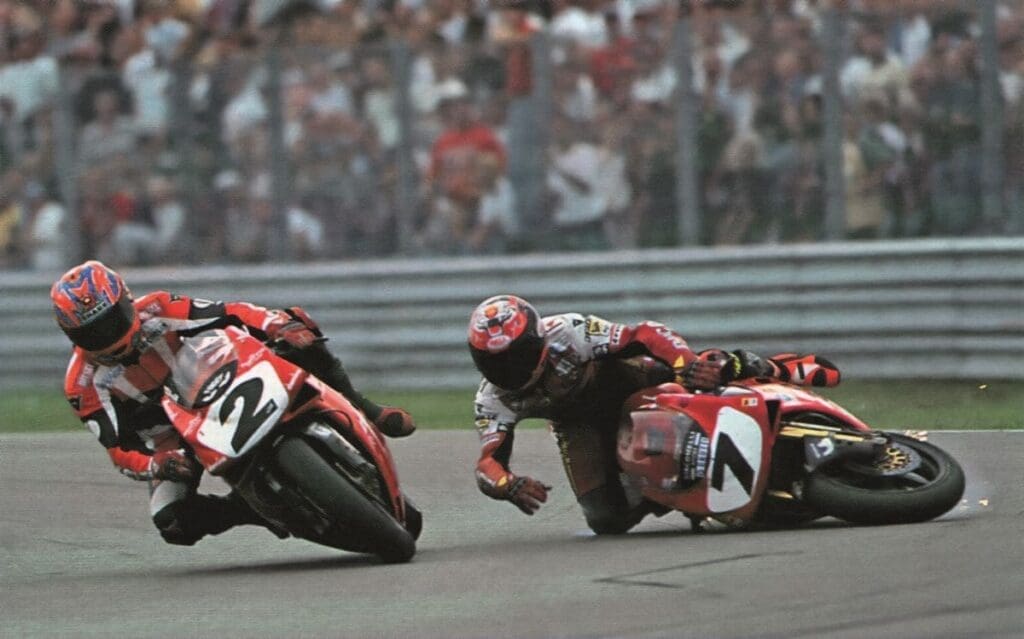
Foggy’s consistency (and three wins) kept him in the hunt until the final round showdown at Sugo. Slight’s five wins were the most he’d taken in a season, while Corser also aimed for consistency (just two wins.) Chili was a five-time winner, the last one coming at the first Assen race. In race two, Foggy out-braked the Italian at the final chicane who crashed, prompting the infamous appearance of Frankie in a towelling robe claiming Carl was a dirty rider. Frankie’s frustration was borne from the news that only the top two Ducati riders in the series would get factory bikes for 1999… At Sugo, Corser ruled himself out with a practice crash which saw him injured. Meanwhile Foggy managed to take the title with a 3rd and 4th place finish, while Slight could only manage 7th and 6th.
After such a close run thing in 1998, 1999 was back to Foggy dominance: 11 wins and 128 points ahead of his nearest rival, Colin Edwards on the soon-to-be-retired RC45. The 1990s were at times both precarious and positive for the Ducati factory. While they dominated the main international production race series as well as winning a number of national championships and – alongside the Kawasaki ZXR/ZX-7RR becoming the machine of choice for privateers – their performance in the showrooms often wasn’t.
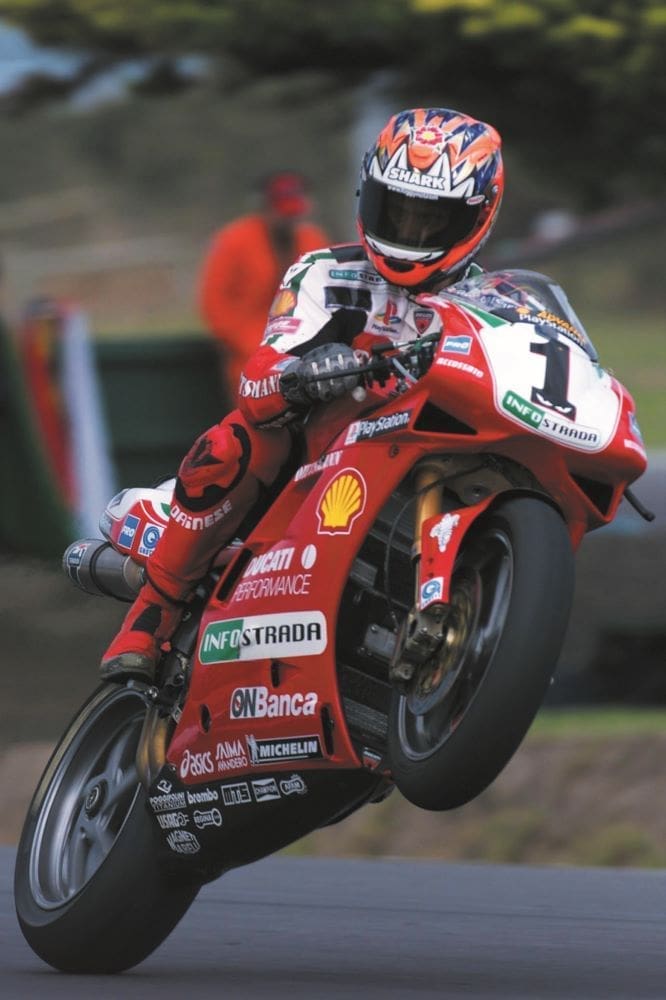
While the ‘win on Sunday, sell on Monday’ mantra would see the 851/888 series and later 916 machines sell well enough, they needed a road machine that would sell in the appropriate numbers. Under Cagiva ownership (headed by brothers Claudio and Gianfranco Castiglioni) the Massimo Tamburini-designed 916 of 1994 would take the plaudits and the championships, but 1993’s Miguel Galluzzi penned Ducati Monster would bring stylish ‘naked’ motorcycles to the masses. Today the Monster accounts for half of Ducati’s sales. Despite Ducati’s up and down history, they would be bought out by the US-based Texas Pacific Group in 1996, resulting in some much-needed investment.
With Ducati’s eighth world title in 10 years the scene was set with Fogarty at the height of his powers… But it would be a new world order from 2000. Carl would be injured in the second event of the year and retire – meanwhile Honda would debut their own V-twin Superbike: but that’s a different story…

